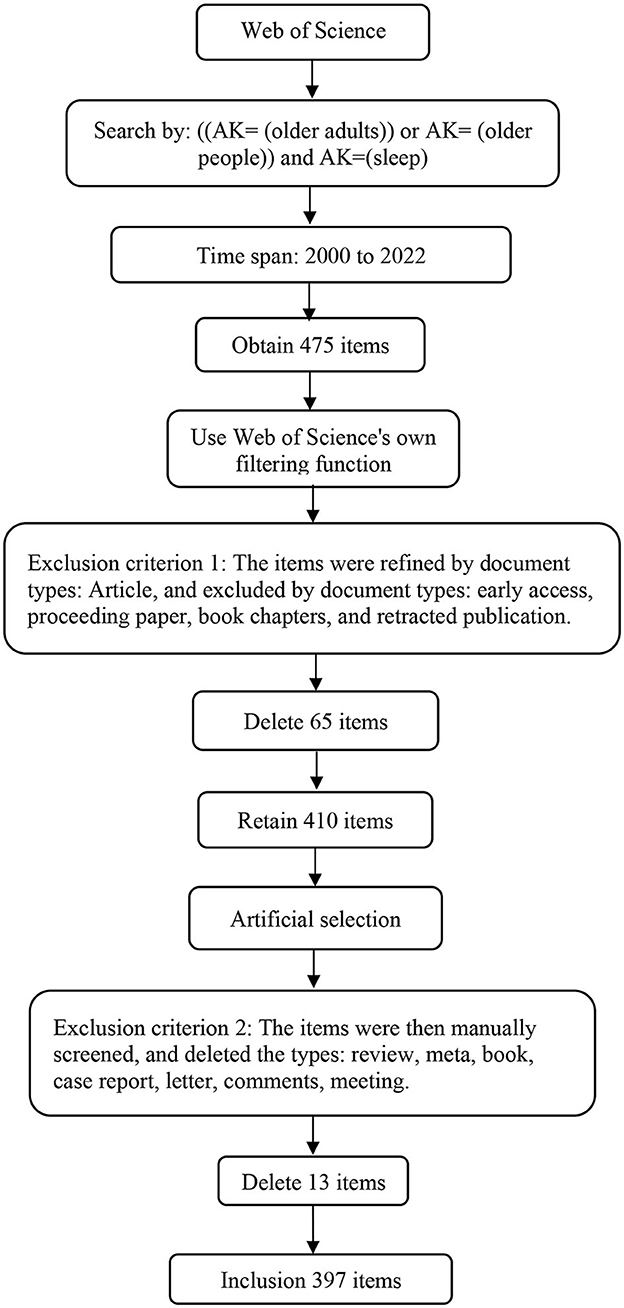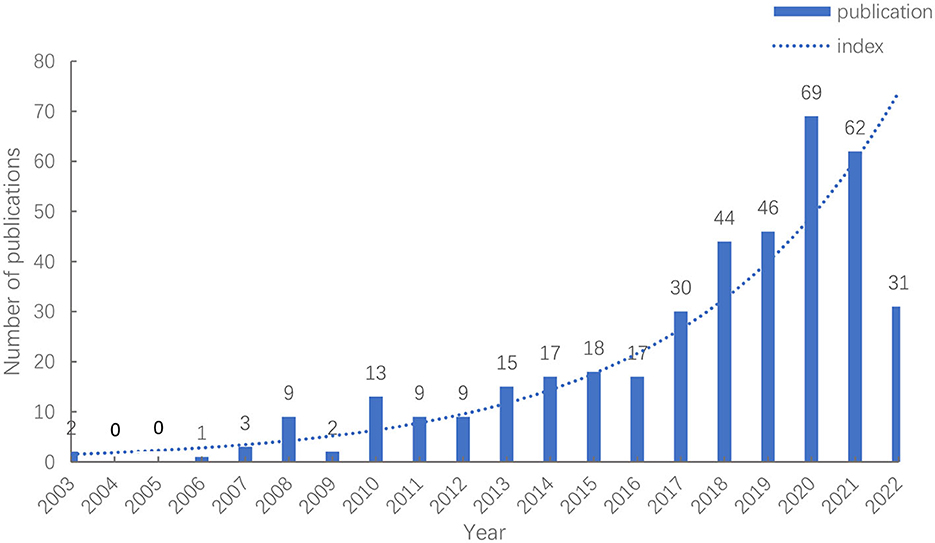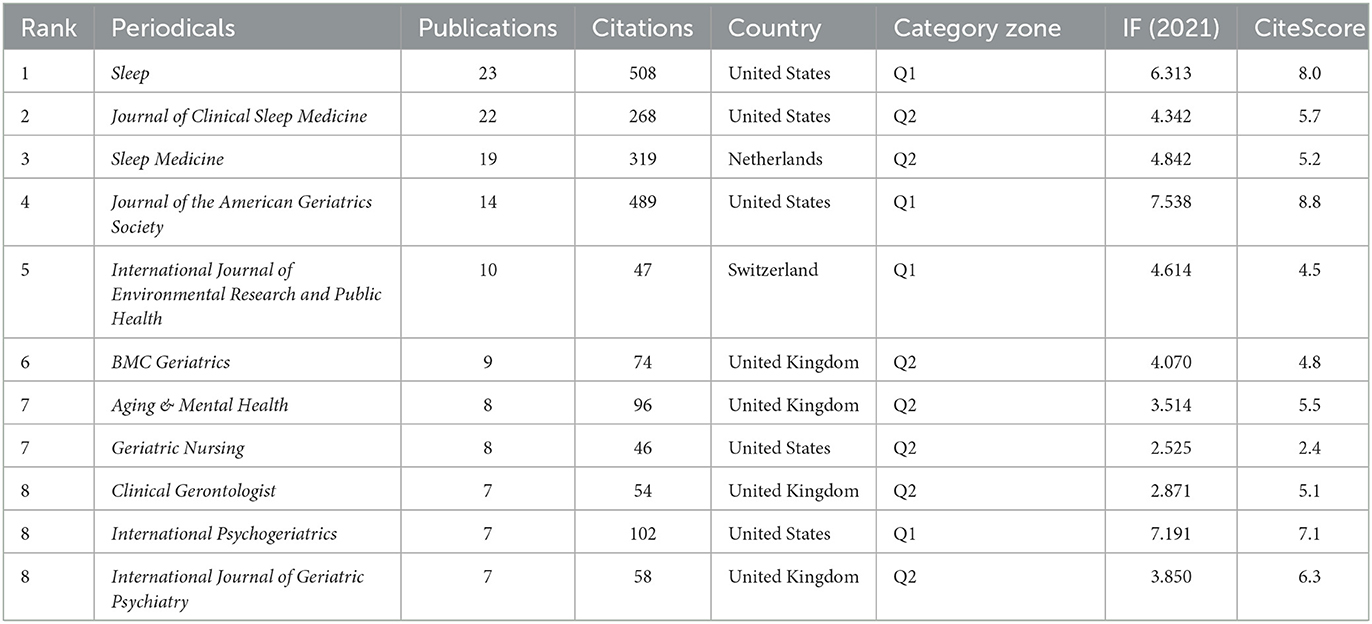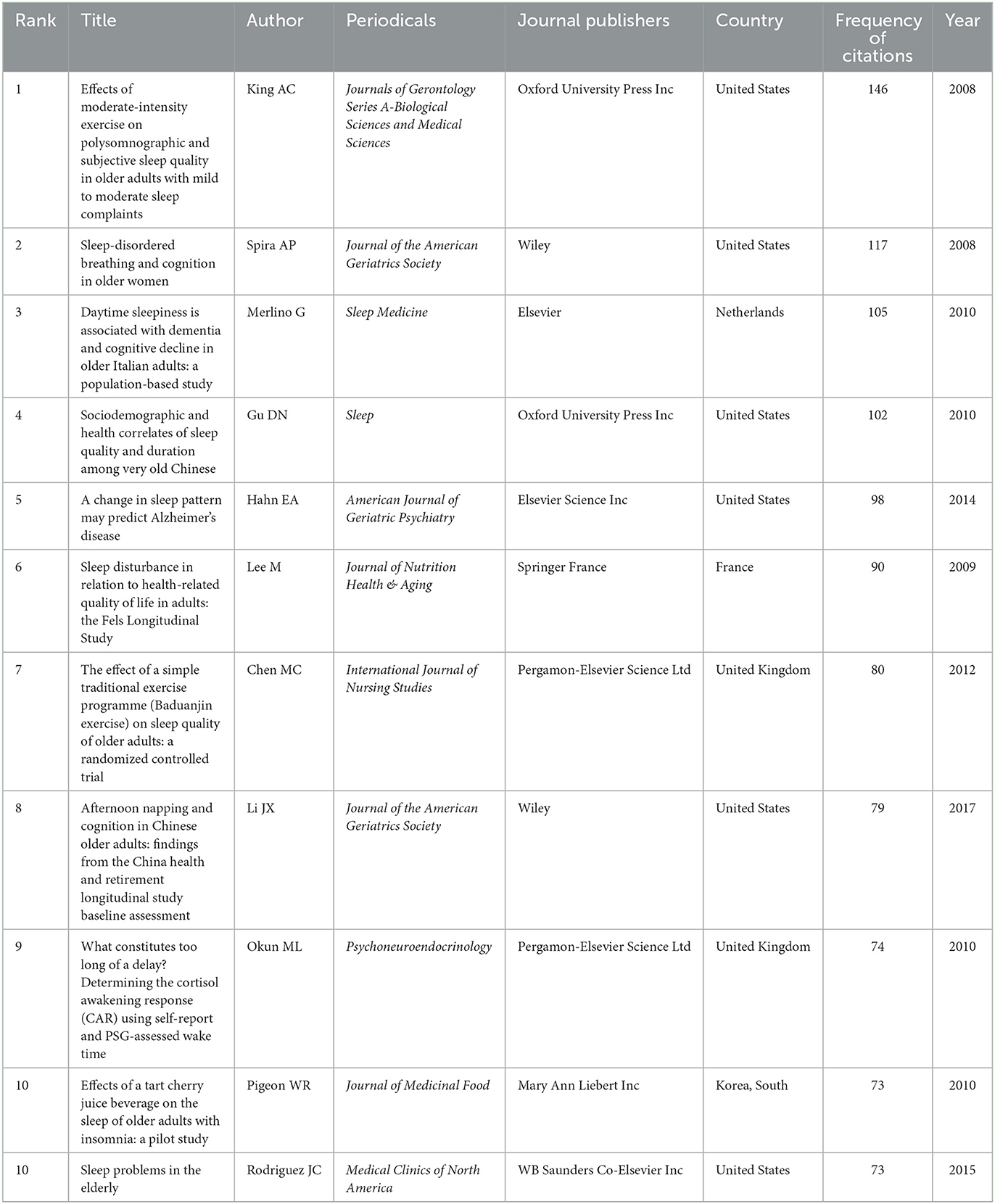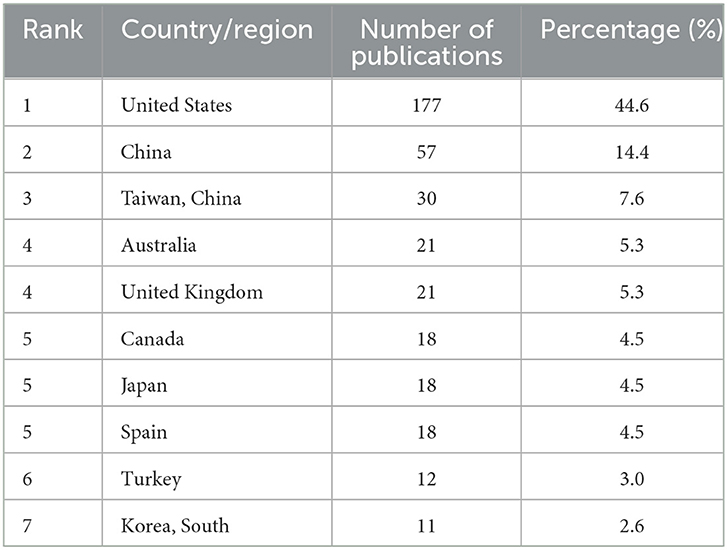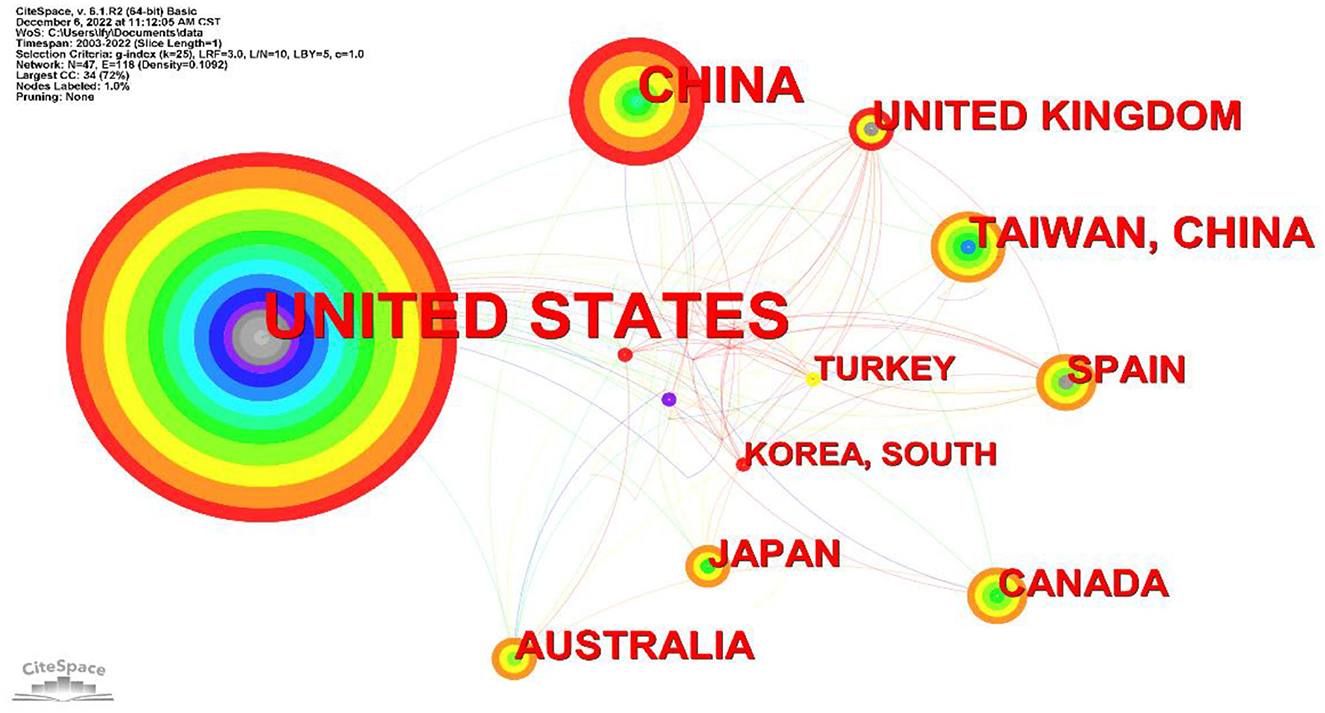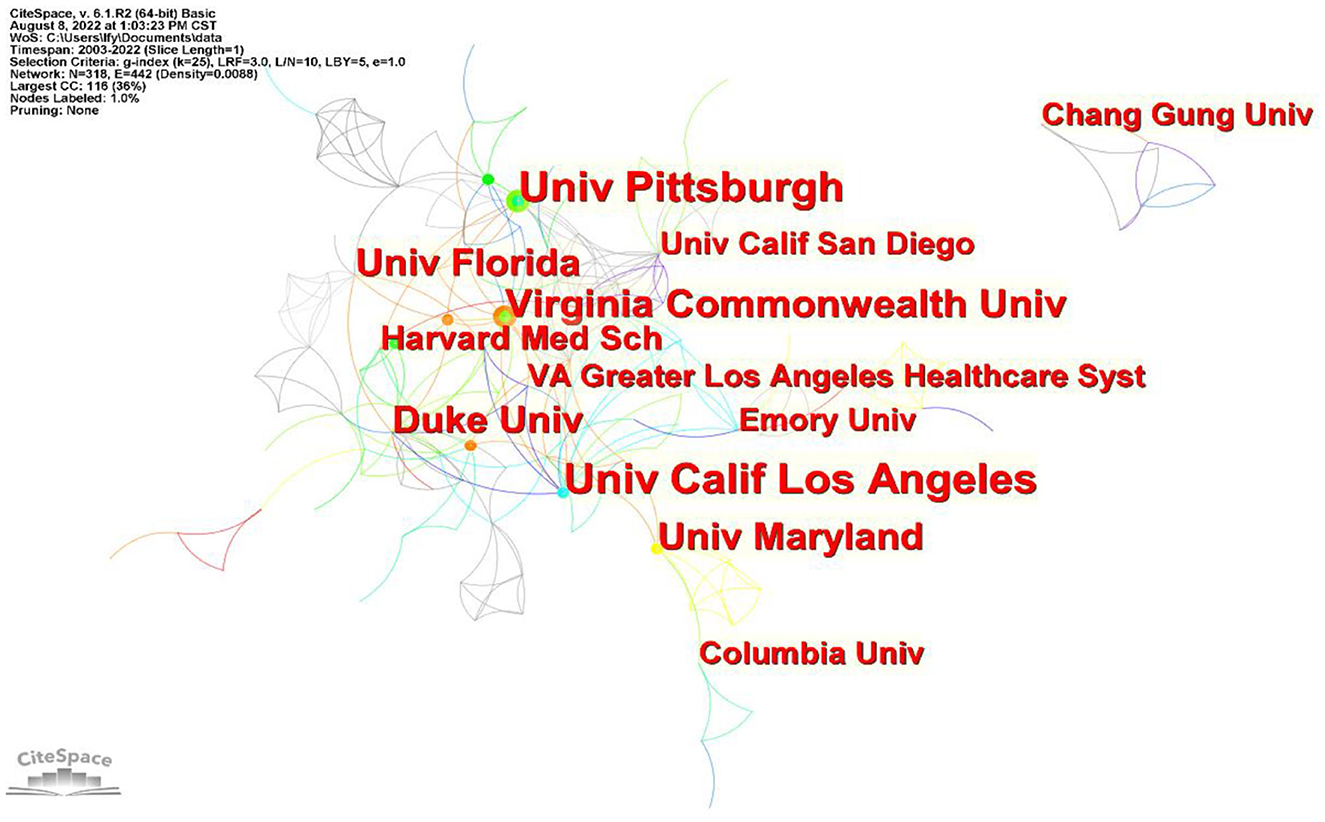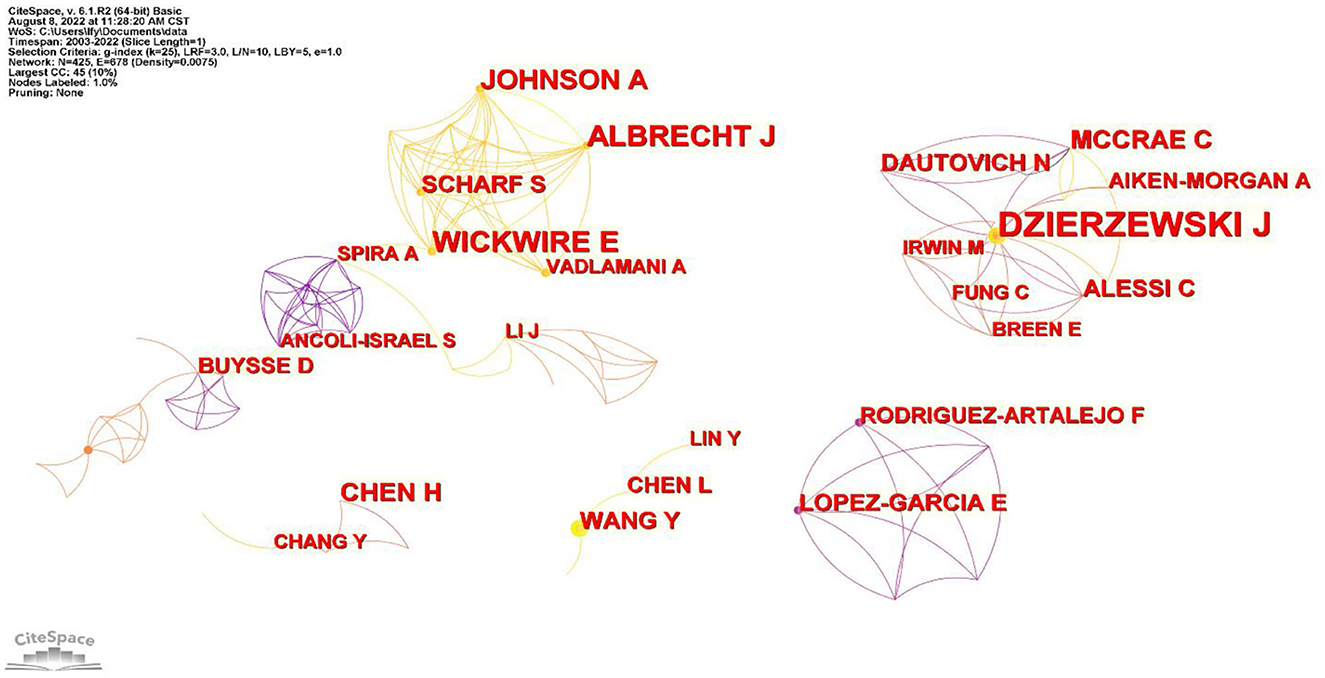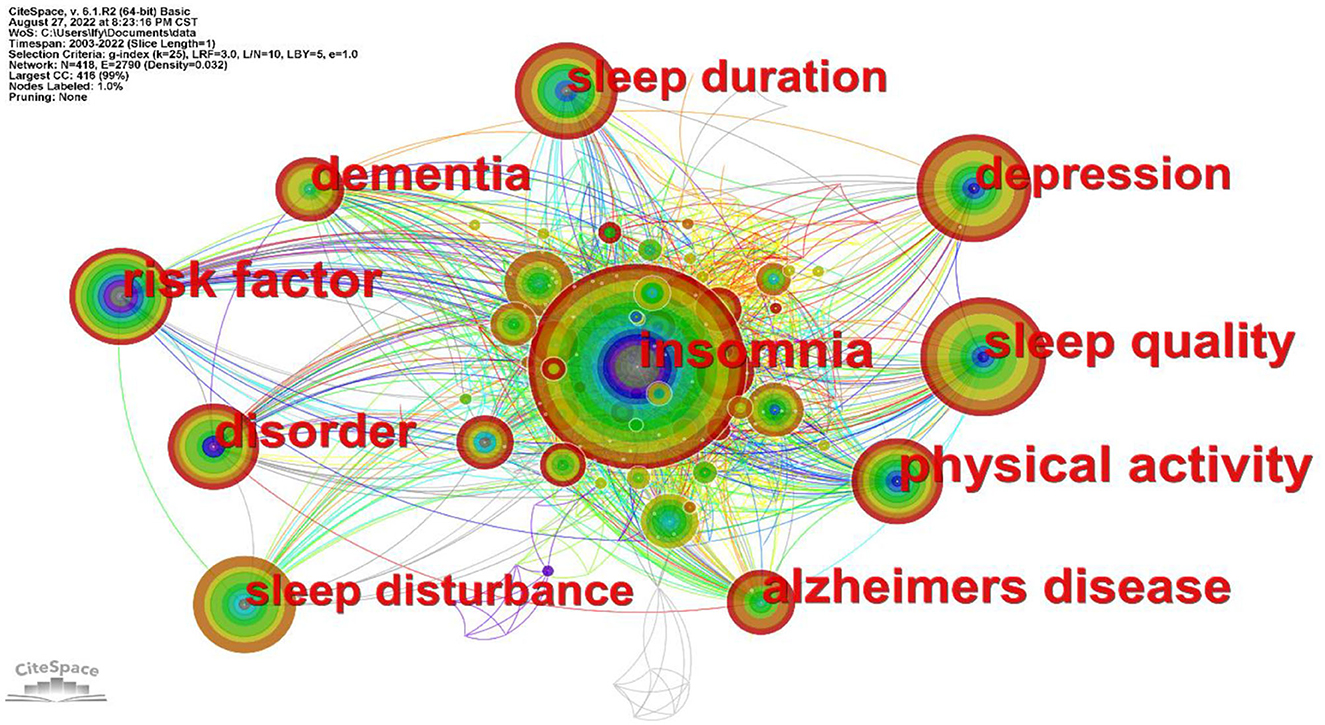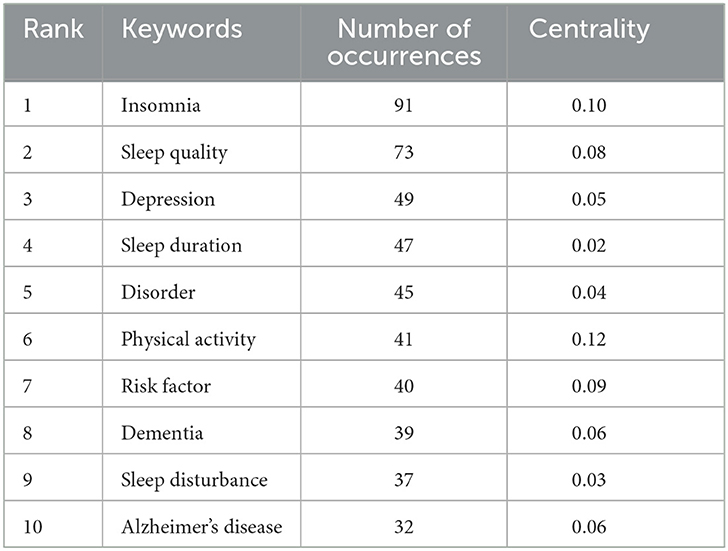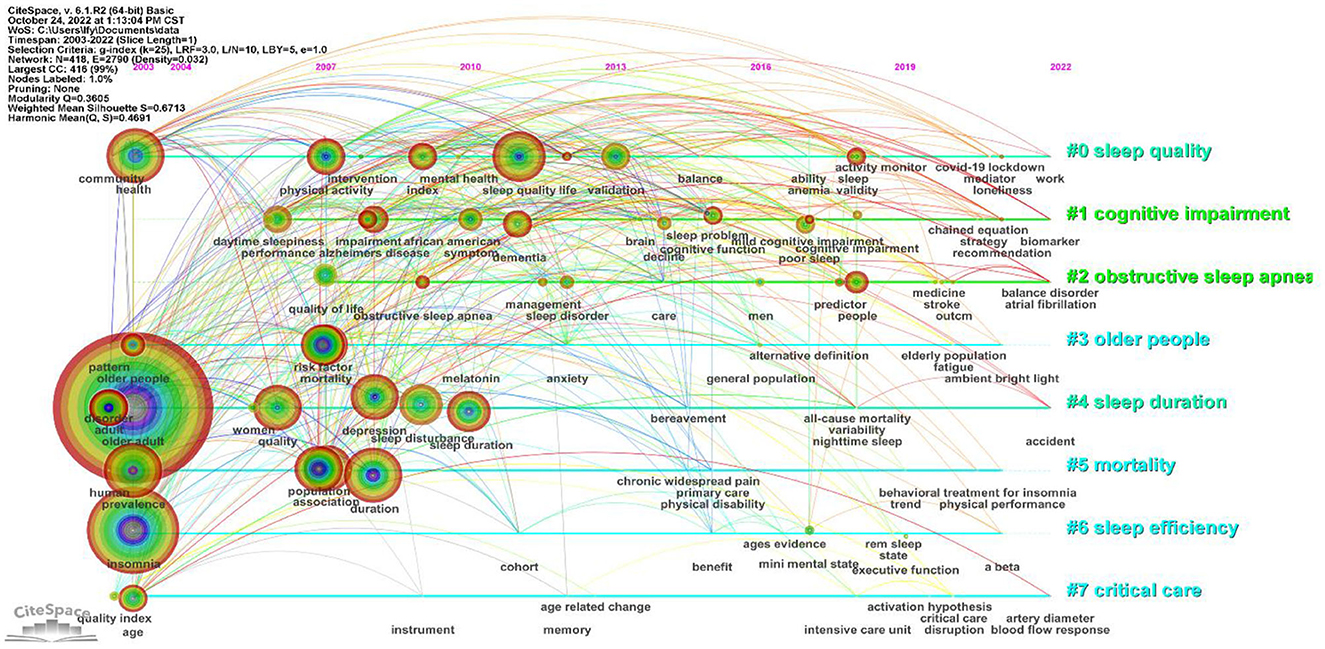- 1College of Physical Education, Henan University, Kaifeng, Henan, China
- 2Research Center of Sports Reform and Development, Henan University, Kaifeng, Henan, China
- 3Institute of Physical Fitness and Health, Henan University, Kaifeng, Henan, China
Background: Sleep problems severely affect the quality of life in the elderly and have gradually gained attention among scholars. As a major hot spot of current research, sleep in older adults is highly exploratory and of great significance for human health.
Objective: Therefore, in this study, the current state of the art of sleep research in older adults was analyzed through the visual mapping function of CiteSpace software. Using this software, we analyzed popular research questions and directions and revealed the development trends and research frontiers of this field.
Methods: In this paper, we searched the Web of Science database for sleep-related studies focusing on older adults and analyzed the number of publications, journals, authors, institutions, country regions, and keywords by using CiteSpace software.
Results: Our results revealed that the number of publications concerning sleep in older adults has gradually increased; after 2017, this field underwent rapid development. The journal Sleep has published the majority of the articles on sleep in older adults and has the highest citation frequency. The Journal of the American Geriatrics Society has the highest impact factor and CiteScore among the top 10 journals in terms of the number of published articles. The United States has the highest number of publications and most of the leading institutions in this field are located in the United States, with the University of California, Los Angeles, and the University of Pittsburgh having the highest number of publications. Dzierzewski JM is the most published author and has played an important role in guiding the development of this field. Research in this area is focused on insomnia, sleep quality, depression, and sleep duration.
Conclusion: The rapid development of sleep research in older adults, which shows a yearly growth trend, indicates that this field is receiving increasing attention from researchers. Insomnia in older adults is the most concerning problem in this field. At the same time, future research should continue to focus on the impact of sleep disorders on older adults to improve sleep and quality of life in older adults.
1. Introduction
The aging population experiences age-related symptoms, such as slowed metabolism, decreased resistance, and decreased physiological functions, and may even develop age spots and memory loss (1). With the increase in age, many older adults have difficulties in falling asleep, short sleep durations, and problems waking up too early, leading to insomnia, which severely affects sleep quality and the physical and mental health of older adults (2). An optimum sleep duration for older adults should be at least 7–8 h of undisturbed sleep daily (3). Due to factors such as age, sex, environment, physical illness, and psychology (4), the sleep patterns of older adults change with prolonged daytime sleep and insufficient nighttime sleep. Therefore, sleep patterns in older adults are easily disturbed by various factors, resulting in easy awakening at night, in addition to reduced sleep capacity and efficiency (5–7).
Sleep disorders (SDs) are symptoms of abnormal amounts of sleep, abnormal behaviors during sleep, and disruptions of the circadian rhythm (alternating patterns of sleep and wakefulness) (8, 9). SDs can be caused by a variety of factors, and they are closely linked to the health of a person. SDs are common in the older population, and the prevalence of SDs may increase due to aging, disease, medication, and psychological factors (10). SDs lead to several adverse consequences, such as memory loss, physical decline, cognitive impairment (11), and risk of falls (12). They can also make people prone to anxiety and depression, and can even increase the prevalence of mental illnesses (13). Therefore, SDs are often considered one of the important risk factor for death in older adults (13).
Good and sufficient sleep is beneficial to the recovery process from physical diseases, and it is necessary for undertaking daily activities. Furthermore, it can improve the quality of life in older adults (14), reduce negative emotions, and enhance physical health (15). There are various ways to improve sleep in the elderly, including exercise, diet, music, etc. Exercise is one of the most important ways. Studies have proven that physical activity can prolong sleep duration, improve heart rate, reduce psychological distress, and improve sleep quality, which are important factors in maintaining physical health in older adults (16). Regular exercise can improve sleep quality and sympathetic nerve function and reduce the risk of cardiovascular and metabolic diseases in older adults (17). Exercise promotes emotional health, reduces the psychological burden of older adults, improves sleep quality, and enhances the quality of life (18, 19). Dietary intake also affects sleep quality. One study found that foods rich in tryptophan and melatonin can improve sleep, and fruit and fiber intake are associated with sleep quality (20). Other studies have shown that music therapy is often used for emotional self-regulation, and insomnia is closely related to mood disorders. Physiologically, music can improve sleep quality in older adults through its effects on the endocrine and autonomic nervous systems (21).
Research on sleep in older adults has gradually increased in recent years. Since elderly sleep is influenced by many aspects, such as sex, sleep habits, physical and mental disorders, and medications, a considerable number of studies exist in this area, and their findings are complicated. Scientific knowledge mapping is a popular research method in the fields of scientometrics and visual analysis, which reveals the development patterns and research hot spots of related fields through visualization (22). With the help of bibliometric methods, we can systematically analyze the impact of sleep research to determine the current research trends and reveal the research dynamics in this area (23). CiteSpace is a citation visualization software program developed in the context of scientometrics and data visualization, which analyzes the citations in the literature of specific regions, presents the structure, pattern, and distribution of scientific knowledge through visualization, and transforms the visualized graphs obtained from the analysis into scientific knowledge maps (24). Therefore, in this paper, we used CiteSpace to analyze the current state of development and trends in sleep research involving older adults to explore popular research questions and directions, reveal the development dynamics and research frontiers in this field, and finally provide insights for its further advancement (25).
2. Data collection and research methods
2.1. Data collection
The data used in this paper were obtained from the Web of Science (WOS) database from 1 January 2000 to 1 August 2022. The search was conducted using author keywords (AK) in the form [AK= (older adults) or AK= (older people)] and AK= (sleep). A total of 475 documents were retrieved, after which the items were refined by document type (article) and excluded by types of publication (early access, proceeding paper, book chapters, and retracted publication); thus, 65 items were excluded. The items were manually filtered by excluding reviews, meta, case reports, books, letters, comments, and meetings, through which 13 items were excluded. A total of 397 items were included in this study (Figure 1). The entire search and screening of the literature were performed on the same day. These retrieved studies were exported in plain text format with full records and cited references and imported into CiteSpace software. No duplicate records were found. The formatted data files in the “output” folder were copied and pasted into the “data” folder for subsequent data analysis.
2.2. Research methods
In this study, CiteSpace 6.1.R2 software was used to map scientific knowledge, and co-occurrence and clustering analyses were performed on high-frequency terms, research institutions, and countries. Finally, 397 papers were included in the study, and the trend maps of publication volume, authorship, institutional cooperation, geographical distribution, and keyword mapping were drawn to highlight key nodes and research hots pots, thus visualizing the field of sleep research in older adults. Each of these plots represents cutting-edge hot spots and trends in scientific research and can be selectively analyzed based on a particular aspect of the problem (24). In addition, when mapping, CiteSpace provides module values (Q-values) and average profile values (S-values) to ensure that mapping is effective. When Q> 0.3, the obtained network structure is significant, and when S> 0.5, the clustering is considered reasonable, whereas S> 0.7 indicates plausible clustering (24). CiteSpace can present domain-specific research trends through quantitative analysis and image visualization. It helps to reveal the development, hot spots, and frontiers of scientific research.
3. Results
3.1. Analysis of the volume of publication
After searching and screening, a total of 397 publications were found in the WOS database between 2000 and 2022. It can be seen in Figure 2 that the number of publications in the field of sleep research in older adults has gradually increased and more rapidly developed over time, showing a positive upward trend overall. In particular, the number of publications rapidly increased after 2017, with more than 60 articles published in 2020 and 2021.
3.2. Analysis of journals
The included literature was organized and ranked according to the number of published articles, resulting in the top 10 journals in terms of the number of articles (Table 1). The research literature focused on elderly sleep mainly involves journals related to sleep medicine, geriatrics, nursing, and psychology. The top 10 journals with the highest number of articles published a total of 134 articles, accounting for 33.8% of the total number of articles. Among them, Sleep ranks first, with 23 articles, and is also first in terms of citation frequency (508). Ranking second and third are the Journal of Clinical Sleep Medicine and Sleep Medicine, with 22 and 19 articles, respectively. The Journal of the American Geriatrics Society ranks fourth in terms of the number of published articles. This journal ranks first in both impact factor (7.538) and CiteScore (8.8). Overall, 5 of the top 10 journals in terms of the number of published articles are from the United States. This is followed by the United Kingdom, with 4 of the top 10 journals.
3.3. Analysis of literature
The top 10 most frequently cited articles are listed in Table 2. The most frequently cited article is Effects of moderate-intensity exercise on polysomnographic and subjective sleep quality in older adults with mild to moderate sleep complaints. This article has 146 citations and is authored by King AC. The article was published in 2008. Among the top 10 cited articles, 4 articles were published in 2010 in Sleep Medicine, Sleep, Psychoneuroendocrinology, and Journal of Medicinal Food. Most of the highly cited articles were published in American journals, namely Journals of Gerontology Series A-Biological Sciences and Medical Sciences, Sleep, American Journal of Geriatric Psychiatry, and Medical Clinics of North.
3.4. Analysis of country/region
As seen from Table 3, the United States is the most active in the field of sleep research in older adults, with the highest number of published papers, accounting for 177 papers (44.6%) of the total. China ranks second with 57 papers, accounting for 14.4% of the total. Taiwan, China, is third with 30 articles, followed by the United Kingdom and Australia with 21 articles each. Canada, Japan, and Spain have 18 articles each, 12 articles have been published in Turkey and 11 articles in Korea, South. Figure 3 is an alternative representation of country/region by the number of publications. The regional distribution of countries can reveal the level of academic research collaboration among various country/region. As shown in Figure 3, there are 47 nodes with 118 connected lines and a network density of 0.1092. This figure shows that researchers in many countries are conducting studies on sleep quality in older adults, with the United States and China forming a relatively dense network of collaboration.
3.5. Analysis of institutional and author collaboration
Figure 4 illustrates the collaboration among institutions in the field of sleep research in older adults. Figure 4 and Table 4 show that the institutions with more publications are mainly universities, with the most publications originating from the University of California, Los Angeles, and the University of Pittsburgh. Both universities are tied for first place with 14 publications. Some other influential research institutions include Virginia Commonwealth University, Duck University, University of Maryland, University of Florida, etc. All the top 10 institutions are from the United States, except Chang Gung University, which is located in Taiwan, China.
The number and size of the nodes in the author collaboration network map show the frequency of co-occurrence, and the number of connected lines indicates the collaborative network between authors, as well as its strength (24). There are 425 nodes and 678 connected lines in Figure 5, with a network density of 0.0075. Table 5 reveals that authors from the United States are highly productive and the most cited. The 4 authors with 10 or more publications are Dzierzewski JM, Mccrae CS, Wickwire EM, and Albrecht JS. Dzierzewski JM from Virginia Commonwealth University, United States, ranks first with 18 publications and has the highest citation frequency (353). Mccrae CS from the United States and Chen HC from Taiwan, China, with 287 and 165 citations, rank second and third, respectively (Table 5).
3.6. Keyword analysis
3.6.1. Keyword co-occurrence analysis
The visual analysis of sleep in older adults was performed using CiteSpace software (Figure 6), and the time slice was set to 1 year, generating 418 nodes with 2,790 connections and a network density of 0.032. The top 10 keywords in terms of frequency of occurrence are listed in Table 6. The most frequent keywords are “insomnia”, “sleep quality”, “depression”, “sleep duration”, “disorder”, etc.
3.6.2. Keyword clustering analysis
In order to better understand the research hot spots in the field of sleep in older adults, a keyword clustering map was drawn by running the CiteSpace visualization software (Figure 7). The scientific nature of the clustering map can be mainly inferred from the module value (Q value) and the average profile value (S value) (22). In this study, we obtained Q = 0.3605, which indicates a good clustering effect, and S = 0.6713, which indicates high homogeneity among the clusters and reasonable clustering results. Additionally, some mapping clusters overlap with each other, indicating that they are closely related. According to the clustering atlas listing and the relevant information of clusters (Table 7), the larger clusters include #0 sleep quality, #1 cognitive impairment, #2 obstructive sleep apnea, #3 older people, #4 sleep duration, #5 mortality, #6 sleep efficiency, and #7 critical care.
To better visualize the research dynamics of sleep research in older adults, a keyword time-zone mapping was developed to show the evolution of research hot spots from 2003 to 2022 (Figure 8). High-frequency keywords mainly revolve around “sleep quality”, “older people”, “sleep duration ”, “mortality”, “sleep efficiency”, and “critical care”. The first series of high-frequency keywords appeared in 2003, including “health”, “older adults”, “insomnia”, “prevalence”, etc. Next, in 2007, other keywords emerged such as “physical activity”, “quality of life”, “risk factor”, “mortality”, “population”, “association”, etc. From 2007 to 2011, “duration”, “depression”, “sleep quality”, etc., increasingly appeared. From 2012 to 2022, other keywords emerged one after another. Based on the keyword analysis in Table 7, it is clear that the popular research topics involving elderly sleep are mainly found in the areas of sleep quality, cognitive dysfunction, obstructive sleep apnea, sleep duration, sleep efficiency, and emergency care.
4. Discussion
With aging-related physiological changes, the sleep schedule of the elderly also changes, with shorter nighttime sleep, more frequent daytime sleep, and reduced sleep duration. The underlying causes for these problems include physical diseases, mental problems, environment, and living conditions. Through the bibliometric analysis of research on elderly sleep with CiteSpace, the current situation and development trend of the elderly sleep research were identified in terms of authors, institutions, journals, countries, and keywords.
The trends in sleep research on older adults are reflected by the number of published papers in recent years. Figure 2 indicates that sleep research in older adults has continuously received extensive attention from scholars in recent years. This is caused by a rapid increase in the aging population in various countries and societies around the world. The incidence of SDs in older adults is increasing due to more people living alone, aging, and declining health (12). As the availability of the literature in this field continues to increase, a more in-depth understanding of sleep patterns in older adults will simultaneously develop.
Sleep ranks first in terms of the number of articles. This indicates that the journal has a high academic advantage and influence in the study of sleep in older adults. The main research directions of Sleep are behavioral sciences, clinical neurology, neurosciences, and psychiatry. The top three journals are all in the field of clinical neurology. The Journal of the American Geriatrics Society focuses on geriatrics gerontology. The journal is ranked first in both impact factor and CiteScore, indicating the high quality of academic papers published in the journal. Other journals in the field of geriatrics include BMC Geriatrics, Geriatrics Nursing, International Psychogeriatrics, International Journal of Geriatric Psychiatry, and Clinical Gerontologist.
Highly cited research is an essential source of scientific knowledge in any field of study, as it indicates the level of research and trends of development in that field and is the scientific basis for exploring the frontiers of research and hot spots (24). The citation frequency of the literature is an important indicator of the influence and quality evaluation of papers, and it is used to evaluate the state of the influence and the quality level of scientific research in different countries, institutions, or individuals (22). The most frequently cited article is Effects of moderate-intensity exercise on polysomnographic and subjective sleep quality in older adults with mild to moderate sleep complaints. The article focused on the effects of exercise interventions on sleep in older adults. It revealed that moderate-intensity exercise improved sleep quality in older adults with mild-to-moderate sleep complaints (26).
The country–region distribution map is a much better depiction of the scientific research differences and distribution in sleep research in each country. Far more papers are published in the United States than in other countries. This indicates that the United States has the highest level of research and influence in the field of sleep research. Figure 3 shows that sleep-related articles surfaced in the United States earlier than in other countries and that the number of published articles is relatively stable. Our results also show that the United States engages in collaborative exchanges with most countries. In contrast, China, Australia, Canada, and other countries have published more articles in recent years. Academic exchanges between various countries and regions are more frequent and closer, which makes the development of sleep research in older adults a positive and continuous process.
University of California, Los Angeles, and the University of Pittsburgh rank first in terms of the number of published papers, indicating their outstanding contributions to this field. The University of California, Los Angeles is the cradle of scientific research and high-tech industry professionals in the United States. It invests a considerable amount of human and material resources into research every year. The mapping of institutional collaboration shows that several US research institutions have active collaborative networks with other institutions and that more opportunities exist for academic exchange and learning. Various institutions learn from each other and contribute to the continued development of related research.
Author collaboration mapping provides a clear view of the research status of individual scholars in a research area and the collaboration among them (Figure 5). It provides a visual representation of the more prolific authors. The study of highly productive authors is more helpful to grasp new trends in elderly sleep research. Additionally, the scholarly influence of authors can be assessed by the number of publications and the frequency of citations, which reflect the academic ability of authors and the recognition of scholars (27). Sleep research in older adults reveals close cooperation among researchers and opportunities for mutual learning and communication. This collaboration is conducive to in-depth advances in this field and has a positive impact on the future direction of its development.
Keywords are high-level summaries of the topic of a paper and reflect the research direction and value of the article. Analysis of keywords in the related literature of a certain field helps explore the research hotspots and development trends in that field (28). Keyword co-occurrence refers to the appearance of different keywords in the same literature (23). A high number of keyword occurrences reflects research hot spots and the developmental directions of the field (29). This analysis indicated that the topics of sleep-related research in older adults have been more concentrated and closely connected in recent years. From keyword analysis, the main condition affecting elderly sleep was found to be insomnia. Insomnia is one of the most common SDs in older adults, and it mainly manifests as difficulty falling asleep and maintaining sleep (30). Divorce, widowhood, smoking, drinking, infrequent participation in sports, and other factors also lead to a higher rate of insomnia in the elderly (31). Older adults with sleep problems are more likely to develop mental disorders such as anxiety and depression (32). Long-term poor sleep is the main etiology for the development of depressive symptoms in older adults. Depressed adults with SDs may experience more severe symptoms, which makes their treatment difficult (33). Keeping the body and mind active and in a good emotional state is an effective strategy against depression. Chronic insomnia in older adults may lead to cognitive dysfunction, causing neuronal damage and memory loss (34). This can increase the risk of dementia and Alzheimer's disease in older adults (35). The risk of insomnia is higher in older adults with respiratory illnesses, and physical disabilities, who need to take medications more often than older adults in better health (36). Other factors that contribute to SDs are behavioral, such as the use of electronic devices at bedtime, which suppresses melatonin production and leads to circadian rhythm disturbances (37). Environmental factors, such as room temperature, light intensity (38), and sound, can affect sleep (39). Poor nutritional conditions can also lead to reduced sleep quality in older adults (40). However, dietary habits can improve sleep in older adults. Increasing the daily consumption of fruits, meat, and eggs can increase the duration of sleep (41). Physiological factors such as snoring, apnea, and abnormal sleep behavior and duration can also interfere with sleep (42). Studies have found that improving physical activity levels has a positive impact on sleep in older adults (43). Therefore, regular exercise will also improve sleep quality, increase sleep duration, prevent cognitive decline, and improve the quality of life of older adults (44).
Some studies have shown that approximately half of older adults suffer from SDs, which is closely related to physical health status (45). The duration of sleep in older adults gradually decreases with age, as the total sleep time is shortened, sleep duration is reduced, sleep efficiency is lowered, waking time at night is prolonged, drowsiness during the day increases, and the circadian rhythm of the body is impaired (46, 47). It was found that the duration of sleep in older adults is related to the degree of frailty; thus, fit older adults sleep better. Additionally, it was observed that sleep is correlated with sex (48). Poor sleep quality and reduced sleep duration are signs of cognitive decline in older adults and can lead to memory loss and depressive symptoms (49). Furthermore, excessive sleep duration can impair cognitive and physiological function in older adults (50). Curtis et al. found that the association between self-reported sleep and cognitive performance interacted with pain in sedentary adults aged 50 years and above (51). Older adults have less energy, spend less time being physically active, and often maintain a sedentary lifestyle, which can lead to a decline in physical health (52). Therefore, older adults should perform more physical activities to improve their sleep quality and reduce sleep disorders. Exercise is an important measure to achieve physical and mental relaxation (53).
5. Limitations
This bibliometric analysis of studies involving elderly sleep was conducted with the help of CiteSpace software, using visual mapping to more graphically reveal the trends and patterns in this field, which in turn led to a series of new findings and interpretations. This paper focused on the number of publications, journals, authors, institutions, countries, and keywords, aiming at a macro analysis of the field, so some important detailed parts were not reflected in the study. CiteSpace software was developed based on the Web of Science Core Collection and, therefore, generally relies on this database for analysis. Thus, our choice of databases was limited. Additionally, we limited the search period to January 2000–August 2022, and those articles published after this period were not included.
6. Conclusion
This bibliometric study focused on sleep quality in older adults, providing detailed information on the relevant literature from a global perspective through visualization with CiteSpace. We found that the number of studies in the field of elderly sleep has increased year by year, especially after 2017, with a sharp increase in the number of publications, indicating that this research area has excellent growth potential. Pioneering research on elderly sleep originates from the United States. The research institutions involved in this area are mainly universities. Research hot spots revolve around insomnia, sleep quality, depression, sleep duration, etc. Research topics include sleep quality, cognitive impairment, obstructive sleep apnea, etc. To summarize, this study predicts future research trends in elderly sleep through visual analysis and can provide valuable insight to help understand the research frontiers and hot spots in this field. At the same time, sleep research in older adults is highly exploratory and deserves further development.
Data availability statement
The original contributions presented in the study are included in the article/supplementary material, further inquiries can be directed to the corresponding author.
Author contributions
HL contributed to conceptualization, design, and supervision. HJ and WH collected data from the database. FL and ZD analyzed the data. HL and FL wrote the original draft. HL made critical revisions of the manuscript. All authors have read and agreed to the published version of the manuscript.
Funding
This work was supported by Henan Science and Technology Development Project grant (202102310320), Henan Higher Education Institutions Key Project grant (23B890001), Henan University Graduate Education Innovation and Quality Improvement Plan Project grant (SYL-AL2022011), and Henan University Teaching Reform Project grant (HDXJJG2021-152).
Conflict of interest
The authors declare that the research was conducted in the absence of any commercial or financial relationships that could be construed as a potential conflict of interest.
Publisher's note
All claims expressed in this article are solely those of the authors and do not necessarily represent those of their affiliated organizations, or those of the publisher, the editors and the reviewers. Any product that may be evaluated in this article, or claim that may be made by its manufacturer, is not guaranteed or endorsed by the publisher.
References
1. Rodriguez J, Dzierzewski J, Alessi C. Sleep problems in the elderly. Med Clin North Am. (2015) 99:431–9. doi: 10.1016/j.mcna.2014.11.013
2. Roberts RE, Shema SJ, Kaplan GA, Strawbridge WJ. Sleep complaints and depression in an aging cohort: a prospective perspective. Am J Psychiatry. (2000) 157:81–8. doi: 10.1176/ajp.157.1.81
3. Hirshkowitz M, Whiton K, Albert SM, Alessi C, Bruni O, DonCarlos L, et al. National sleep Foundation's sleep time duration recommendations: methodology and results summary. Sleep Health. (2015) 1:40–3. doi: 10.1016/j.sleh.2014.12.010
4. Bjelajac A, Holzinger B, Lucanin J, Delale E, Lucanin D. Sleep quality and daytime functioning in older European adults. Eur Psychol. (2020) 25:186–99. doi: 10.1027/1016-9040/a000406
5. Vanderlinden J, Boen F, van Uffelen JGZ. Effects of physical activity programs on sleep outcomes in older adults: a systematic review. Int J Behav Nutr Phys Act. (2020) 17:11. doi: 10.1186/s12966-020-0913-3
6. Reyes S, Algarin C, Bunout D, Peirano P. Sleep/wake patterns and physical performance in older adults. Aging Clin Exp Res. (2013) 25:175–81. doi: 10.1007/s40520-013-0028-7
7. Pye J, Phillips A, Cain S, Montazerolghaem M, Mowszowski L, Duffy S, et al. Irregular sleep-wake patterns in older adults with current or remitted depression. J Affect Disord. (2021) 281:431–7. doi: 10.1016/j.jad.2020.12.034
9. Nadorff M, Drapeau C, Pigeon W. Psychiatric illness and sleep in older adults comorbidity and opportunities for intervention. Sleep Med Clin. (2018) 13:81–91. doi: 10.1016/j.jsmc.2017.09.008
10. Miner B, Kryger MH. Sleep in the aging population. Sleep Med Clin. (2017) 12:31–8. doi: 10.1016/j.jsmc.2016.10.008
11. Kondo R, Miyano I, Lee S, Shimada H, Kitaoka H. Association between self-reported night sleep duration and cognitive function among older adults with intact global cognition. Int J Geriatr Psychiatry. (2021) 36:766–74. doi: 10.1002/gps.5476
12. Tufan A, Ilhan B, Bahat G, Karan MA. An under-diagnosed geriatric syndrome: sleep disorders among older adults. Afr Health Sci. (2017) 17:436–44. doi: 10.4314/ahs.v17i2.18
13. Alvaro PK, Roberts RM, Harris JK. A systematic review assessing bidirectionality between sleep disturbances, anxiety, and depression. Sleep. (2013) 36:1059–68. doi: 10.5665/sleep.2810
14. Stallings D, Lach H, Lorenz R. Circadian rhythm and quality of life in older adults. Appl Nurs Res. (2022) 66:151457. doi: 10.1016/j.apnr.2021.151457
15. Gothe NP, Ehlers DK, Salerno EA, Fanning J, Kramer AF, McAuley E. Physical activity, sleep and quality of life in older adults: influence of physical, mental and social well-being. Behav Sleep Med. (2020) 18:797–808. doi: 10.1080/15402002.2019.1690493
16. Stefan L, Vrgoc G, Rupcic T, Sporis G, Sekulic D. Sleep duration and sleep quality are associated with physical activity in elderly people living in nursing homes. Int J Environ Res Public Health. (2018) 15:2512. doi: 10.3390/ijerph15112512
17. Tseng T-H, Chen H-C, Wang L-Y, Chien M-Y. Effects of exercise training on sleep quality and heart rate variability in middle-aged and older adults with poor sleep quality: a randomized controlled trial. J Clin Sleep Med. (2020) 16:1483–92. doi: 10.5664/jcsm.8560
18. Weber M, Schnorr T, Morat M, Morat T, Donath L. Effects of mind–body interventions involving meditative movements on quality of life, depressive symptoms, fear of falling and sleep quality in older adults: a systematic review with meta-analysis. Int J Environ Res Public Health. (2020) 17:6556. doi: 10.3390/ijerph17186556
19. Williams J, Kay D, Rowe M, McCrae C. Sleep discrepancy, sleep complaint, and poor sleep among older adults. J Gerontol Ser B-Psychol Sci Soc Sci. (2013) 68:712–20. doi: 10.1093/geronb/gbt030
20. Zuraikat FM, Wood RA, Barragán R, St-Onge M-P. Sleep and diet: mounting evidence of a cyclical relationship. Annu Rev Nutr. (2021) 41:309–32. doi: 10.1146/annurev-nutr-120420-021719
21. Wang C, Li G, Zheng L, Meng X, Meng Q, Wang S, et al. Effects of music intervention on sleep quality of older adults: a systematic review and meta-analysis. Complement Ther Med. (2021) 59:102719. doi: 10.1016/j.ctim.2021.102719
22. Zhao D. Exploring some issues of scientific knowledge mapping based on CiteSpace. Intell Theory Practice. (2012) 35:56–58. doi: 10.16353/j.cnki.1000-7490.2012.10.005
23. Zhao J. A study on CiteSpace visualization process and analysis paradigm. Knowl Econ. (2014) 328:105–107. doi: 10.15880/j.cnki.zsjj.2014.16.208
24. Chen Y, Chen C, Liu Z, Hu Z, Wang X. Methodological functions of CiteSpace knowledge graphs. Scientol Res. (2015) 33:242–253. doi: 10.16192/j.cnki.1003-2053.2015.02.009
25. Aria M, Cuccurullo C. bibliometrix: An R-tool for comprehensive science mapping analysis. J Informetr. (2017) 11:959–75. doi: 10.1016/j.joi.2017.08.007
26. King A, Pruitt L, Woo S, Castro C, Ahn D, Vitiello M, et al. Effects of moderate-intensity exercise on polysomnographic and subjective sleep quality in older adults with mild to moderate sleep complaints. J Gerontol Ser -Biol Sci Med Sci. (2008) 63:997–1004. doi: 10.1093/gerona/63.9.997
27. Wang Y, Shou X, Wu Y, Fan Z, Cui J, Zhuang R, Luo R. Relationships between obstructive sleep apnea and cardiovascular disease: a bibliometric analysis (2010–2021). Med Sci Monit. (2022) 28:933448. doi: 10.12659/MSM.933448
28. Li B. Web of science-based analysis of the research posture of high-intensity interval training in sports science. Sports Sci Technol. (2019) 40:13–14. doi: 10.14038/j.cnki.tykj.2019.05.007
29. Chen C, Chen Y, Horowitz M, Hou H, Liu Z, Pellegrino D. Towards an explanatory and computational theory of scientific discovery. J Informetr. (2009) 3:191–209. doi: 10.1016/j.joi.2009.03.004
30. Foley DJ, Monjan A, Simonsick EM, Wallace RB, Blazer DG. Incidence and remission of insomnia among elderly adults: an epidemiologic study of 6,800 persons over three years. Sleep. (1999) 22:S366–72.
31. Morgan K. Daytime activity and risk factors for late-life insomnia. J Sleep Res. (2003) 12:231–8. doi: 10.1046/j.1365-2869.2003.00355.x
32. Li MJ, Kechter A, Olmstead RE, Irwin MR, Black DS. Sleep and mood in older adults: coinciding changes in insomnia and depression symptoms. Int Psychogeriatr. (2018) 30:431–5. doi: 10.1017/S1041610217001454
33. Fang H, Tu S, Sheng J, Shao A. Depression in sleep disturbance: a review on a bidirectional relationship, mechanisms and treatment. J Cell Mol Med. (2019) 23:2324–32. doi: 10.1111/jcmm.14170
34. Shi L, Chen S-J, Ma M-Y, Bao Y-P, Han Y, Wang Y-M, et al. Sleep disturbances increase the risk of dementia: a systematic review and meta-analysis. Sleep Med Rev. (2018) 40:4–16. doi: 10.1016/j.smrv.2017.06.010
35. Someren EJW, Hagebeuk EEO. Lijzenga C, Scheltens P, deRooij SEA, Jonker G, et al. Circadian rest-activity rhythm disturbances in Alzheimer's disease. Biol Psychiatry. (1996) 40:259–70. doi: 10.1016/0006-3223(95)00370-3
36. Zimmerman ME, Aloia MS. Sleep-disordered breathing and cognition in older adults. Curr Neurol Neurosci Rep. (2012) 12:537–46. doi: 10.1007/s11910-012-0298-z
37. Wood B, Rea MS, Plitnick B, Figueiro MG. Light level and duration of exposure determine the impact of self-luminous tablets on melatonin suppression. Appl Ergon. (2013) 44:237–40. doi: 10.1016/j.apergo.2012.07.008
38. Shishegar N, Boubekri M, Stine-Morrow E, Rogers W. Tuning environmental lighting improves objective and subjective sleep quality in older adults. Build Environ. (2021) 204:108096. doi: 10.1016/j.buildenv.2021.108096
39. Desaulniers J, Desjardins S, Lapierre S, Desgagne A. Sleep environment and insomnia in elderly persons living at home. J Aging Res. (2018) 2018:8053696. doi: 10.1155/2018/8053696
40. Zhao W, Zhang Y, Jia S, Ge M, Hou L, Xia X, et al. The association of sleep quality and sleep duration with nutritional status in older adults: Findings from the WCHAT study. Maturitas. (2021) 145:1–5. doi: 10.1016/j.maturitas.2020.10.013
41. Fan H, Lee Y, Chang Y, Shelley M. Associations of dietary habits and sleep in older adults: a 9-year follow-up cohort study. Eur Geriatr Med. (2021) 12:123–31. doi: 10.1007/s41999-020-00377-0
42. Mortazavi SS, Foroughan M, Hosseini SA, Nasiri E, Shahbazi F. Negative factors affecting the sleep quality of the elderly in Iran: a systematic review. Arch Rehabil. (2021) 22:132–53. doi: 10.32598/RJ.22.2.3011.1
43. Naylor E, Penev PD, Orbeta L, Janssen I, Ortiz R, Colecchia EF, et al. Daily social and physical activity increases slow-wave sleep and daytime neuropsychological performance in the elderly. Sleep. (2000) 23:87–95. doi: 10.1093/sleep/23.1.1f
44. Dzierzewski J, Buman M, Giacobbi P, Roberts B, Aiken-Morgan A, Marsiske M, et al. Exercise and sleep in community-dwelling older adults: evidence for a reciprocal relationship. J Sleep Res. (2014) 23:61–8. doi: 10.1111/jsr.12078
45. Li J, Vitiello MV, Gooneratne NS. Sleep in normal aging. Sleep Med Clin. (2018) 13:1–11. doi: 10.1016/j.jsmc.2017.09.001
46. Gu D, Sautter J, Pipkin R, Zeng Y. Sociodemographic and health correlates of sleep quality and duration among very old Chinese. Sleep. (2010) 33:601–10. doi: 10.1093/sleep/33.5.601
47. Mesas A, Lopez-Garcia E, Leon-Munoz L, Guallar-Castillon P, Rodriguez-Artalejo F. Sleep duration and mortality according to health status in older adults. J Am Geriatr Soc. (2010) 58:1870–7. doi: 10.1111/j.1532-5415.2010.03071.x
48. Akin S, Ozer F, Zararsiz G, Safak E, Mucuk S, Arguvanli S, et al. The impact of sleep duration on frailty in community-dwelling Turkish older adults. Sleep Biol Rhythms. (2020) 18:243–8. doi: 10.1007/s41105-020-00264-y
49. Guo H, Zhang Y, Wang Z, Shen H. Sleep quality partially mediate the relationship between depressive symptoms and cognitive function in older Chinese: a longitudinal study across 10 years. Psychol Res Behav Manag. (2022) 15:785–99. doi: 10.2147/PRBM.S353987
50. Zhao Y, Lu Y, Zhao W, Wang Y, Ge M, Zhou L, et al. Long sleep duration is associated with cognitive frailty among older community-dwelling adults: results from West China Health and Aging Trend study. BMC Geriatr. (2021) 21:608. doi: 10.1186/s12877-021-02455-9
51. Curtis A, Dzierzewski J, Buman M, Giacobbi P, Roberts B, Aiken-Morgan A, et al. Preliminary investigation of interactive associations of sleep and pain with cognition in sedentary middle-aged and older adults. J Clin Sleep Med. (2021) 17:233–42. doi: 10.5664/jcsm.8856
52. Reid KJ, Baron KG, Lu B, Naylor E, Wolfe L, Zee PC. Aerobic exercise improves self-reported sleep and quality of life in older adults with insomnia. Sleep Med. (2010) 11:934–40. doi: 10.1016/j.sleep.2010.04.014
Keywords: aged, older adults, sleep, bibliometrics, CiteSpace
Citation: Liu H, Liu F, Ji H, Dai Z and Han W (2023) A bibliometric analysis of sleep in older adults. Front. Public Health 11:1055782. doi: 10.3389/fpubh.2023.1055782
Received: 28 September 2022; Accepted: 06 February 2023;
Published: 23 February 2023.
Edited by:
Saeid Safiri, Tabriz University of Medical Sciences, IranReviewed by:
Akbar Azizi Zeinalhajlou, Tabriz University of Medical Sciences, IranNahid Karamzad, Tabriz University of Medical Sciences, Iran
Seyed Ehsan Mousavi, Tabriz University of Medical Sciences, Iran, in collaboration with reviewer NK
Copyright © 2023 Liu, Liu, Ji, Dai and Han. This is an open-access article distributed under the terms of the Creative Commons Attribution License (CC BY). The use, distribution or reproduction in other forums is permitted, provided the original author(s) and the copyright owner(s) are credited and that the original publication in this journal is cited, in accordance with accepted academic practice. No use, distribution or reproduction is permitted which does not comply with these terms.
*Correspondence: Haitao Liu,  aG55bGxodEAxMjYuY29t
aG55bGxodEAxMjYuY29t
†These authors have contributed equally to this work
 Haitao Liu
Haitao Liu Feiyue Liu
Feiyue Liu Haoyuan Ji1
Haoyuan Ji1